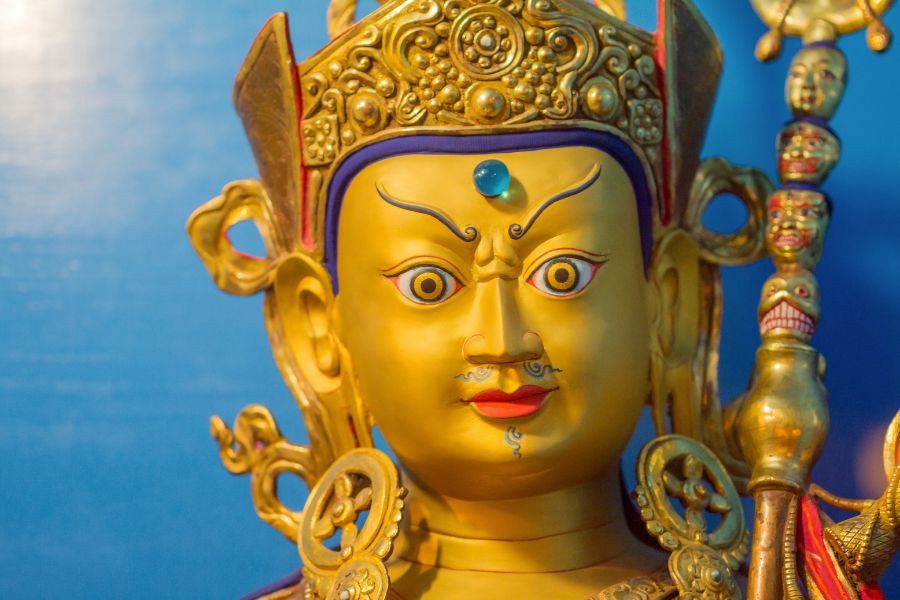This month begins with a spiritual bang! On Sunday we have Padmasambhava Day, a Triratna Buddhist festival that we celebrate every year. Over the last few weeks, lots of you have asked me about Padmasambhava and why, in Triratna, we celebrate him. So I thought I’d give a little explanation of this intriguing character from the Buddhist lineage, who has a central place on the Triratna Refuge Tree. When next at the Centre have a close look at Trish’s painting of the Refuge Tree. Can you spot him? You may also notice the painting above the Tea counter, an unusual image of Padmasambhava sitting on top of our Buddhist Centre!
Padmasambhava is credited with bringing Buddhism into Tibet and overcoming the seemingly insurmountable obstacles that exist when trying to introduce a new way of life and a new religion into a country. He is regarded by many Tibetan Buddhists as a fully Enlightened Buddha. Padmasambhava lived in the 8th Century in the Swat Valley, in his lifetime it was called the Land of Urgyen (Uddiyāna in Sanskrit), in what is now modern day Pakistan. He studied and taught at the great Buddhist University Nalanda in North Eastern India. As part of the recent Ipswich Pilgrimage, we visited Nalanda and got a sense of the size and importance of this institution to Buddhism over the seven centuries that it functioned.
Those at Nalanda taught many forms of traditional Buddhism but it was a ‘hot-house’ of new and innovative forms of Buddhism that were spread around the world. Whilst at Nalanda Padmasambhava became a great teacher of one of the Esoteric Buddhist Schools, the Mantrayana, often referred to as Tantra, or the Vajrayana.
These Esoteric Schools spread into China, Indonesia and Japan, as well as the Himalayan countries Sikkim and Bhutan. In the West we generally only know of these schools via Tibet, and then only because of the exodus of Tibetan Buddhist teachers following the Chinese invasion during the 1950’s.
So why is a figure from the 8th Century so important to Triratna, a modern Buddhist movement? There are two answers to this question. Firstly we can see in the story of Padmasambhava a parallel with the Triratna movement. Buddhism had existed in Tibet, for several centuries with some ‘traditional’ schools. Buddhist Centre’s and monasteries had been built in Tibet but all had been destroyed. Buddhism could not flourish until Padmasambhava introduced a new form, one that resonated with the Tibetan people and their culture. His first Buddhist Temple was called Samye. (The Shrine of Unchanging Spontaneous Presence).
In the early 1800’s Buddhism was introduced into the UK, and in 1881 The Pali Text Society was created. The Buddhist Society was founded in 1924 which meant Buddhist texts were becoming available in English. However, the introduction of Buddhism into English society has been slow, mainly because of the culturally inappropriateness of the form of Buddhism introduced. When I researched Buddhism in the 1970’s there was little to find, just the odd lecture by an exotic looking exponent of an Asian-Pacific form of Buddhism, from Sri Lanka or Japan.
Triratna, founded by Urgyen Sangharakshita in 1967, introduced into this country a new form of Buddhism, more appropriate to our modern ‘western’ society. It was quickly taken up, and Buddhism has grown and Triratna Centres have spread around the country and into Europe and beyond. You can see how there are strong connections with the story of Padmasambhava bringing Buddhism into Tibet.
The second answer is that Padmasambhava has played a significant part in Urgyen Sangharakshita’s own story and journey. Sangharakshita first came upon a figurine of Padmasambhava in a small temple in Darjeeling in 1950 at the beginning of his 14-year stay in Kalimpong. The figure had an immediate and strong effect on Sangharakshita.
“Though I had never seen the figure of Padmasambhava before, it was familiar to me in a way that no other figure on earth was familiar: familiar and fascinating. It was as familiar as my own self, yet at the same time infinitely mysterious, infinitely wonderful, and inspiring it was to remain. Indeed from then on the figure of the Precious Guru – Guru Rimpoche – was to occupy a permanent place in my inner spiritual world”
Urgyen Sangharakshita – From his book Facing Mount Kanchenjunga.
Twelve years later in October 1962 Bhanté (Sangharakshita) received the Padmasambhava initiation and practice from Kachu Rimpoche, the abbot of Pemayangtse Monastery in Sikkim. The relationship between Padmasambhava and Sangharakshita was such that he was even given the title ‘Urgyen’ by Kachu Rimpoche, which signifies a really deep connection between them. In his memoir, Precious Teachers, he describes how the bestowal of the name suggested to him that his ‘true home was in the mysterious land of Uddiyāna’.
This is how the lineage of Padmasambhava lives on. While alive Bhanté passed on the Padmasambhava initiation to many Order Members, ensuring the qualities of Padmasambhava are harnessed to continue the spread of Buddhism. I am sure that Padmasambava and Sangharakshita would be pleased to hear that just a few days ago a new Triratna Buddhist Centre was opened in Chelmsford not far from Ipswich. We are following in eminent footsteps – bringing Buddhism into a new city, and a new land.
As Buddhists we too can have a small part of the spirit of Padmasambhava. Passing on what we have learned about Buddhism to those around us. I look forward to see you on Sunday, to celebrate Padmasambhava Day and spend time in his magical and mysterious world.
Bodhivamsa

